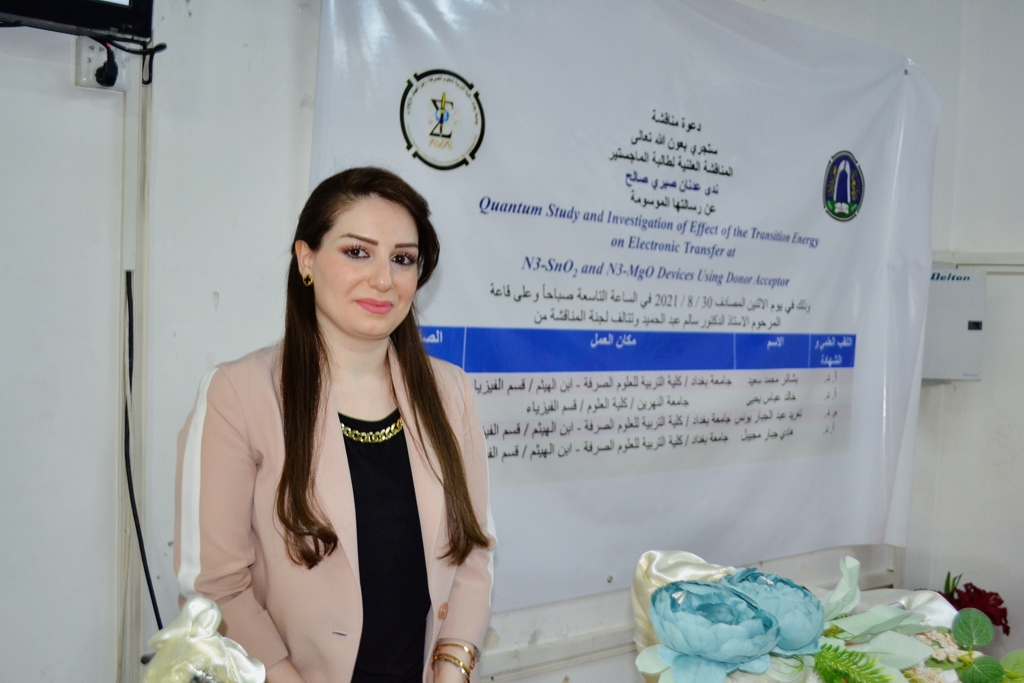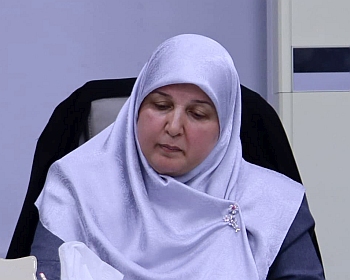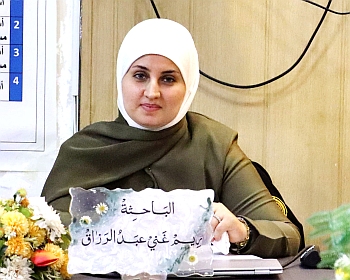ناقش قسم الفيزياء في كلية التربية للعلوم الصرفة (ابن الهيثم) رسالة الماجستير الموسومة (دراسه كميه نظريه في تأثير الطاقه الانتقاليه على الالكترون المنتقل في انظمه N3-SnO2 و N3-MgO بأستخدام طريقة المانح-المستقبل) للطالبة (ندى عدنان صبري) التي انجزتها تحت اشراف التدريسي في القسم (أ.د. هادي جبار مجيبل) ونوقشت من قبل أعضاء لجنة المناقشة المبينة أسمائهم فيما يأتي :
-
أ.د. بشائرمحمد سعيد (رئيساً)
-
أ.د. خالد عباس يحيى (عضواً)
-
م.د. تغريد عبد الجبار يونس (عضواً)
-
أ.د. هادي جبار مجيبل (عضواً و مشرفاً)
ويهدف البحث الى :
-
دراسة الانتقال الإلكتروني عند الجزيء المتصل بأشباه الموصلات اعتمادًا على النموذج الكمومي ونظرية الانتقال لماركوس .
-
ايجاد معدل الانتقال الإلكتروني عند صبغة – باستخدام الحسابات الكميه. MgO و SnO2 المتحسسه للضوء والمرتبطه بشبه الموصل N3
-
دراسة تأثير الطاقة الانتقالية على نقل الإلكترون لأجهزة N3/MgO و N3/SnO2
-
دراسة تأثير القطبية على انتقال الطاقة ومعدل النقل الإلكتروني لجهازي – N3/MgO و N3/SnO2 المذكوره انفا.
-
دراسة تأثير اقتران الجهد والقوة على معدل التحويل الإلكتروني للجهازين.
-
كل هذه المعلمات تعطي مزيدًا من المعلومات لتحسين كفاءة أجهزة الخلايا الشمسية.
في هذه الدراسة، قدمنا انموذج نظري لحساب التيار المار خلال نظام جزيئة-صبغة N3 المستضاءة والملاصقة لشبه الموصل اوكسيد المغنيسيوم (MgO) اوثنائي اوكسيد القصدير (SnO2) باستعمال طريقة المانح-المستقبل للألكترونات في عمل الخلية الشمسية.
ان من خلال حساب التيار تم تطوير كفاءة الخلايا الشمسية في النبائط N3-SnO2 و N3-MgO، اذ تم استخدام النموذج النظري المعتمد على النظرية الكمية للأنتقال لدراسة تفاعل الانتقال الالكتروني لسطح تلامس الجزيئة المتحسسة (N3) المرتبطة مع اشباه الموصلات MgO او SnO2.
تم دراسة الحسابات النظرية من خلال استخدام نظرية الانتقال الكمي والمستويات الميكانيكية الجزيئية المعتمدة على ترتيب الذرات في مستويات طاقة التوصيل في اشباه الموصلات، اذ تم استخدام مذيبات مختلفة مثل: 1-2-دايمثوكسي ايثين، ايثانول، ميثانول، كلوروبنزين، 2-ميثوكسي ايثانول، بريدين، ان-ان-دايميثل ثلفورماميد كوسيط لاتمام عمل النظام. اما فيما يخص طاقة الانتقال فقد تم الحصول عليها من خلال طريقة المانح-المستقبل للكم والتي تعتمد على نصف القطر لذرات الصبغة (N3) وذرات اشباه الموصل (MgO او SnO2) وكذلك المعتمدة على ثابت العزل ومعامل الانكسار للمذيبات. ان طاقة الانتقال للنبيطتين المستخدمة تتزايد بتزايد ثابت العزل وتتناقص بتناقص معامل الانكسار، لذلك فان التيار يتناقص مع زيادة القوة الدافعة وذلك نتيجة لتناقص الجهد الكيميائي لصبغة N3.
ان كلاً من النبائط N3-SnO2 و N3-MgO قد اظهرت زيادة بالتيار لمختلف المذيبات عندما كانت طاقة القوة الدافعة تتفاوت بين 0.2eV – 0.8 eV، ان النتائج البيانات للتيار في كلا النظامين اظهرت ان التيار يتزايد مع تناقص كلاً من الجهد وطاقة القوة الدافعة. كانت اعلى قيمة للتيار في حالة ان طاقة القوة الدافعة تساوي 0.2eV وجهد واطئ، حيث ان الجهد هو عامل محدد للأنتقال الالكتروني.
تم اثبات في هذه الدراسة ان عملية نقل الالكترون لعبت دوراً مهماً في خصائص النبائط N3-SnO2 و N3-MgO، فقد اظهرت النتائج ان معدل نقل الالكترون لنبيطة N3-MgO هو الاعلى مقارنةً باقل معدل لنبيطة N3-SnO2، وكذلك بينت النتائج ان مذيب الميثانول هو افضل موصل في عملية الانتقال الالكتروني لكلا النبيطتين.
Quantum Study and Investigation of Effect of the Transition Energy on Electronic Transfer at N3-SnO2 and N3-MgO Devices Using Donor Acceptor
By Nada Adnan Sabri Saleh
Supervised by Prof. Dr. Hadi Jabbar Mujbil Al Agealy
Aims of the study
This thesis involves some novelty points include
Studying the electronic transfer at molecule contacted to semiconductor depending on quantum model drives due to transition theory
Investigation the electronic transfer rate at sensitized N3 dye contacted to MgO and SnO2 using quantum calculation
Studying the effect of transition energy on electron transfer of both N3 – MgO and N3 – SnO2 devices.
Studying the effect of the polarity on the transition energy and electronic transfer rate of the two N3 – MgO and N3 – SnO2 devices.
Studying the effect of potential and strength coupling on electronic transfer rate of the two devices.
All these parameters are giving more knowledge to improve the efficiency of solar cell devices
Abstract
In this thesis, a theoretical model for electron transport rate approach has been used to study the Electron Transfer (ET) properties in non-homogeneous N3-MgO and/or SnO2 systems. The process at the interface of sensitizer molecule Dye N3 contact with MgO and/or SnO2 semiconductors materials are studied using a quantum model. We present the characteristic of ET at sensitizer N3 molecule dye contact to MgO and SnO2 semiconductors due to calculate the electronic transfer rate and transition energy using theoretical model. The transition energy and ET rate in N3/MgO and N3/SnO2 devices are important factors in modifying the efficiency in solar cell applications. The effects of the transition energy, driving force, potential, and coupling strength on the ET are presented. The calculations have been performed using the quantum transition theory and molecular mechanics level, based on alignment of molecule energy levels with conduction energy levels of semiconductor. Different solvents 1,2-Dimethoxyethane, Ethanol, Methanol, Chlorobenzene, 2-Methoxyethanol, Pyridineand N,N-Dimethyl formamide are taken as a polar media for N3- MgO and/or SnO2 devices. The transition energy is determined by the donor-acceptor scenario, depending on the radii of N3 and MgO or SnO2, the dielectric constant, and the refractive index of the solvents. The transition energy of the charge carriers increased with increasing the dielectric constant and decreasing the refractive index of the solvents. In addition, the transition energy is strongly related to the refractive index and the dielectric constant, and it is increased with increasing the dielectric constant and decreasing the refractive index. The electronic rate increased with increasing the transition energy and both the N3- MgO and N3 – SnO2 devices show the maximum rate with methanol solvent, while it has minimum rate with Chlorobenzene solvents. Also, the electronic rate increased with decreasing the driving force energy and increasing the coupling strength. However, with increasing the coupling and ET rate, the driving energy is going to decrease. It can be shown that the ET process played a significant role in the characteristics of N3/MgO and N3/SnO2 systems. The results show that the rate of ET is the highest for N3/MgO device compare to the lowest rate for N3/SnO2 devices. The calculation of transition energy and ET rate reveals that solvent has good media for the ET process in both system devices. The interplay between the energy levels between sensitized N3 and MgO interface with good polar media indicate the higher electronic rate of the N3/MgO
Conclusion
Analysis of the calculation results shows that the electrons transfer rate is highest with the N3/MgO device assigned to the alignment two energy levels of N3 and MgO. The estimation of the transition rate of the electrons shows that the Methanol solvent with both systems is large. It reveals that Methanol solvent is the best media to electron transfer process in both devices. The electronic transfer rate of the N3/MgO device is highest compare with N3/SnO2 devices for all solvents .Higher electronic transfer rate of the N3/MgO indicates the alignment of energy levels for both sensitizer dye molecule N3 and MgO semiconductor with good polar media.











